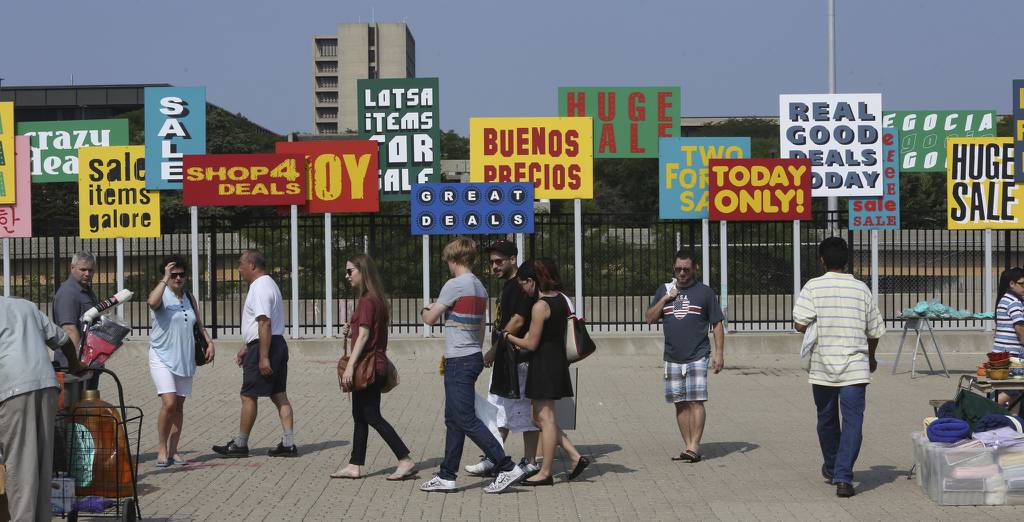
Op-Ed by Steve Balkin: Maxwell Street Market has a rich history and deserves the support that would allow it to thrive
I applaud the Tribune for writing about the success of Rubi’s Tacos, moving from the all-outdoors new Maxwell Street Market to a bricks-and-mortar restaurant in the Pilsen neighborhood. Their food is great, and they attracted world-class foodies to do cable TV segments about them and the market.
What some may not know is that Rubi’s was pushed to a fixed location. They and other vendors have been pushed to move from the new Maxwell Street Market because of the consequences of the pandemic, bad weather, bad communication, lack of market promotion and the lack of indoor alternatives during periods of bad weather. For any face-to-face business to be successful, it needs continuity at the location there during operating hours, and it needs to know how to mitigate bad weather.
The old Maxwell Street Market began in the aftermath of the Great Chicago Fire in 1871. The old Maxwell Street neighborhood was spared by the fire, and it quickly became a place to supply the rest of the city with food and construction supplies. The residents were mainly German and Irish. With the pogroms following the assassination of Czar Alexander II in 1881, Eastern European Jews started to move into that neighborhood, needing a cheap place to live, shop and start a business.
Two other circumstances enriched the characteristics of the neighborhood: the Great Migration of African Americans from the Deep South to Chicago before and just after World War I and the second wave of the Great Migration during World War II and for two decades after that. The migration of Mexicans displaced by the Mexican revolution starting in 1910 led to a chain migration of relatives to the Maxwell Street area seeking jobs..
The city of Chicago was glad to recognize the market as an official public street market in 1912 because it encouraged poor people to shop and stay out of the Loop. Black people, Mexicans, Jews and other lower-income minorities were welcome to work in Chicago but not to go into white neighborhoods.
Until the 1990s, the old Maxwell Street neighborhood remained a place for immigrants and minority communities. It became a generator of cultural riches: home to bandleader Benny Goodman, blues musician Little Walter, CBS founder Bill Paley, activist Saul Alinsky, Maxwell Street Polish inventor Jimmy Stefanovic and Harold Fox, who invented the zoot suit.
The market was successful because it was embedded in a residential neighborhood with six-day-a-week fixed-location shops; had tasty, cheap food from stands and restaurants; was next door to the huge South Water Street wholesale produce market; and had some of the best free blues and gospel entertainment on the globe. The wealth caused by the acquisition of social capital grew enormously.
In the 1990s, as a gentrification policy, the market was destroyed by Mayor Richard M. Daley and the University of Illinois at Chicago. A new market was created six blocks away but with annual vendor fees that increased from $25 to $1,000. The market was moved twice, and each time, the number of vendors and shoppers declined.
The market is run by the Department of Cultural Affairs and Special Events. A couple of years ago, the market was operating every Sunday during the year. Then, it was closed for January and February. Now it is closed during Christmas and New Year’s and in January, February and March. Reducing days of operation makes easier work for the cultural affairs office but less income for market vendors.
I have shopped at the mostly outdoor Swap-O-Rama flea market at 41st Street and Ashland Avenue on cold Sundays in December, January and February when the new Maxwell Street Market is closed, and there are tons of shoppers there, even when they have to pay an admission fee.
Chicago in the past few years has lost population and tourists. Four signature amenities in Chicago include its history, the blues, shopping and food. The new Maxwell Street Market touches all four. Yet, most people in Chicago have never heard of it and don’t know it exists.
I contacted Choose Chicago, the agency responsible for tourism promotion in Chicago, and officials there replied that it is not their concern. Whoever is the new mayor, whether Brandon Johnson or Paul Vallas, he needs to address the shortcomings of the way the new Maxwell Street Market is treated by the agencies that are supposed to run and promote it.
Three issues confronting Chicago are violence, population loss and the need for more economic opportunity on the South and West sides. The market addresses all three. It promotes improved human relations within and across race and class, it’s an amenity that has attracted people to live here, and it is an entrepreneurial incubator for low-income and working-class people.
It is important that the new Maxwell Street Market stay in its present location just six blocks from Union Station, on Desplaines Street, just east of Interstates 90 and 94, directly across from UIC. It should be improved with added features such as volunteer theatrical and circus performers, low rider displays, pony rides, a carousel and a place to buy BBQ ribs.
In addition, there should be other Maxwell Street Markets, especially on the South and West sides. This is not rocket science, but it is an institution that requires care, thoughtfulness and respect for Chicago history.
